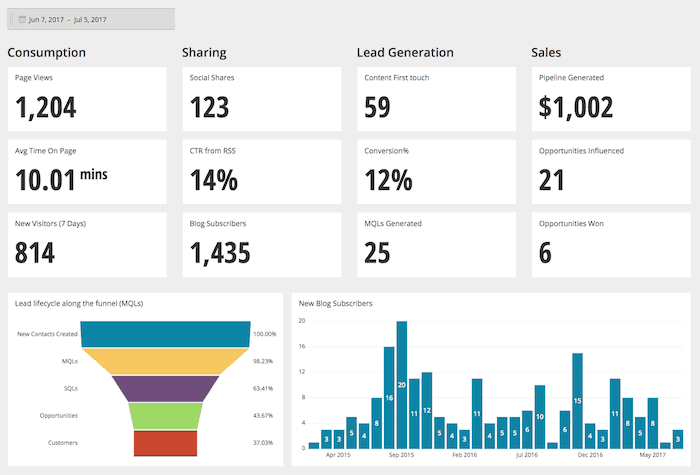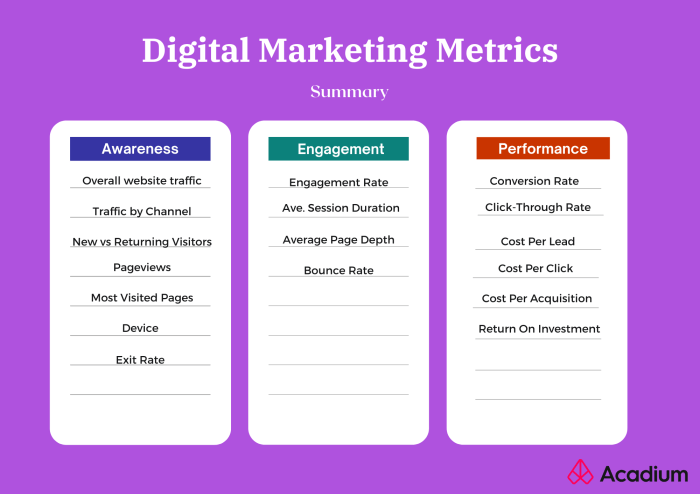Tracking Marketing Metrics Effectively is the key to unlocking business growth and success. By closely monitoring essential metrics, businesses can make informed decisions that drive results and profitability. Dive into this guide to discover the secrets of effective metric tracking.
From understanding the importance of tracking metrics to selecting the right tools and implementing data-driven strategies, this comprehensive overview will equip you with the knowledge needed to excel in the competitive world of marketing.
Importance of Tracking Marketing Metrics

Tracking marketing metrics is like having a GPS for your business – it helps you stay on the right path and make necessary adjustments along the way. By monitoring key metrics, businesses can gain valuable insights into the effectiveness of their marketing strategies, identify areas for improvement, and make data-driven decisions to drive growth.
Examples of Key Marketing Metrics
- Conversion Rate: This metric measures the percentage of website visitors who take a desired action, such as making a purchase or signing up for a newsletter. A high conversion rate indicates that your marketing efforts are effective in driving customer engagement.
- Customer Acquisition Cost (CAC): CAC helps businesses understand how much it costs to acquire a new customer. By tracking this metric, companies can evaluate the efficiency of their marketing campaigns and optimize their spending to maximize ROI.
- Return on Investment (ROI): ROI measures the profitability of marketing campaigns by comparing the revenue generated to the amount spent on marketing. This metric is crucial for determining the success of marketing initiatives and allocating resources effectively.
How Tracking Metrics Helps in Making Informed Business Decisions
Tracking marketing metrics provides businesses with real-time data and actionable insights that can guide decision-making processes. By analyzing trends and performance indicators, companies can identify opportunities for growth, optimize marketing strategies, and allocate resources more efficiently.
Setting Clear Objectives for Tracking Metrics

Setting clear objectives for tracking marketing metrics is crucial for the success of any marketing campaign. By establishing measurable goals, businesses can effectively track their progress and make data-driven decisions to optimize their strategies. Here are the steps to set clear and measurable marketing objectives:
Establishing Clear and Measurable Marketing Objectives, Tracking Marketing Metrics Effectively
- Identify Key Performance Indicators (KPIs) relevant to your business goals.
- Define specific targets for each KPI, such as increasing website traffic by 20% or improving conversion rates by 15%.
- Ensure that objectives are realistic, achievable, and aligned with the overall marketing strategy.
- Set a timeline for achieving these objectives to track progress effectively.
Aligning Metrics with Business Goals
- Linking metrics to specific business goals helps in determining the impact of marketing efforts on overall success.
- By aligning metrics with business objectives, companies can prioritize data that directly contributes to their bottom line.
- This alignment ensures that marketing activities are focused on driving results that matter most to the business.
Importance of Setting Realistic Targets
- Setting realistic targets for each metric is essential to avoid setting unattainable goals that can demotivate the team.
- Realistic targets provide a clear benchmark for measuring success and progress over time.
- By setting achievable goals, businesses can build momentum and celebrate small wins along the way.
Choosing the Right Tools for Tracking
When it comes to tracking marketing metrics effectively, selecting the right tools is crucial for the success of your business. With the plethora of marketing analytics tools available in the market, it can be overwhelming to choose the most suitable one for your specific needs. Here, we will compare different marketing analytics tools, share tips on selecting the most appropriate tool, and discuss the advantages of using integrated analytics platforms for comprehensive tracking.
Comparing Marketing Analytics Tools
- Google Analytics: A widely-used free tool that provides detailed insights into website traffic and user behavior.
- HubSpot: Ideal for inbound marketing strategies, offering features like lead tracking and social media monitoring.
- Adobe Analytics: Suitable for large enterprises with advanced analytics needs, providing in-depth data analysis and visualization.
Tips for Selecting the Right Tool
- Identify your specific business goals and objectives to determine the metrics you need to track.
- Consider your budget and resources available for implementing and managing the analytics tool.
- Look for user-friendly interfaces and customizable reporting features to meet your unique tracking requirements.
Advantages of Integrated Analytics Platforms
Integrated analytics platforms offer a centralized dashboard for tracking various marketing channels, allowing for a holistic view of your marketing efforts.
| Advantages | Description |
|---|---|
| Streamlined Reporting | Consolidates data from multiple sources for easy analysis and reporting. |
| Cross-Channel Insights | Provides a comprehensive view of customer interactions across different marketing channels. |
| Improved Decision-Making | Enables data-driven decision-making by integrating all marketing data into one platform. |
Implementing a Data-driven Strategy: Tracking Marketing Metrics Effectively
Implementing a data-driven strategy is crucial for optimizing marketing performance by making informed decisions based on actual data rather than assumptions or guesswork. By leveraging data analytics, businesses can identify trends, patterns, and insights that help them tailor their marketing efforts more effectively to reach their target audience and achieve their goals.
Role of A/B Testing
A/B testing plays a pivotal role in refining marketing campaigns based on tracked metrics. This method involves comparing two versions of a marketing asset, such as an email, landing page, or ad, to see which one performs better in terms of engagement, conversions, or other key metrics. By conducting A/B tests, marketers can gather valuable data on what resonates with their audience and make data-backed decisions to optimize their campaigns for better results.
- By testing different elements like headlines, images, calls-to-action, or layouts, marketers can identify what works best and iterate on their strategies to improve performance.
- A/B testing helps in minimizing risks by allowing marketers to make incremental changes and measure their impact, rather than making drastic changes based on assumptions.
- Successful A/B testing can lead to higher conversion rates, increased engagement, and ultimately, a more effective marketing strategy that drives results.
Examples of Successful Data-driven Marketing Strategies
Amazon’s personalized recommendations based on user behavior and purchase history have significantly increased their sales and customer retention rates.
Netflix’s data-driven content recommendations have helped them attract and retain subscribers by offering personalized viewing suggestions based on viewing habits and preferences.
Sports apparel brand Nike leverages data analytics to target specific customer segments with personalized marketing messages and product recommendations, leading to higher customer engagement and loyalty.






